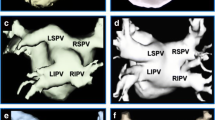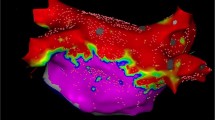Abstract
Purpose
The best strategy for durable left atrial posterior wall isolation (PWI) after completion of pulmonary vein isolation (PVI) is not yet determined. This study aimed to examine the differences in the durability of PWI based on the isolation process and the predictors of the reconduction of PWI.
Methods
Among the 221 patients (mean age, 65 ± 11 years) with consecutive non-paroxysmal atrial fibrillation (AF) who completed PVI and PWI, 50 patients undergoing repeat AF ablation were enrolled and divided into the following groups based on how PWI was achieved at the initial procedure: by only the first line on the roof and floor line (group A), by additional gap ablation to the first line or second liner ablation next to the first line (group B), and by adjunct ablation inside the PW revealing the earliest activation (group C).
Results
Reconduction of PWI occurred in 24 of the 50 patients (48%). The durability of PWI in groups A, B, and C was 81% (17 of 21 patients), 75% (6 of 8 patients), and 14% (3 of 21 patients), respectively (p < 0.01). In a multivariate analysis, the ablation inside the PW for PWI was the independent predictor of the reconduction of PWI (p < 0.001).
Conclusion
PWI achieved by the ablation inside the PW resulted in a high rate of reconduction. It may be necessary to aim to achieve the PWI without ablating the inside of the PW to prevent reconduction.



Similar content being viewed by others
Data availability
Not applicable.
Code availability
Not applicable.
References
Benjamin EJ, Wolf PA, D’Agostino RB, Silbershatz H, Kannel WB, Levy D. Impact of atrial fibrillation on the risk of death: the Framingham Heart Study. Circulation. 1998;98:946–52.
Wazni OM, Marrouche NF, Martin DO, Verma A, Bhargava M, Saliba W, Bash D, Schweikert R, Brachmann J, Gunther J, Gutleben K, Pisano E, Potenza D, Fanelli R, Raviele A, Themistoclakis S, Rossillo A, Bonso A, Natale A. Radiofrequency ablation vs antiarrhythmic drugs as first-line treatment of symptomatic atrial fibrillation: a randomized trial. JAMA. 2005;293:2634–40.
Thiyagarajah A, Kadhim K, Lau DH, Emami M, Linz D, Khokhar K, Munawar DA, Mishima R, Malik V, O'Shea C, Mahajan R, Sanders P. "Feasibility, safety, and efficacy of posterior wall isolation during atrial fibrillation ablation: a systematic review and meta-analysis". Circ Arrhythm Electrophysiol. 2019; [E-pub ahead of print]. https://doi.org/10.1161/CIRCEP.118.007005.
Markman TM, Hyman MC, Kumareswaran R, Arkles JS, Santangeli P, Schaller RD, Supple GE, Frankel DS, Riley MP, Lin D, Garcia F, Dixit S, Callans DJ, Marchlinski FE, Nazarian S. Durability of posterior wall isolation after catheter ablation among patients with recurrent atrial fibrillation. Heart Rhythm. 2020;17:1740–4.
Verma A, Jiang CY, Betts TR, Chen J, Deisenhofer I, Mantovan R, Macle L, Morillo CA, Haverkamp W, Weerasooriya R, Albenque JP, Nardi S, Menardi E, Novak P, Sanders P, STAR AF II Investigators. Approaches to catheter ablation for persistent atrial fibrillation. N Engl J Med. 2015;372:1812–22.
Marrouche NF, Wilber D, Hindricks G, Jais P, Akoum N, Marchlinski F, Kholmovski E, Burgon N, Hu N, Mont L, Deneke T, Duytschaever M, Neumann T, Mansour M, Mahnkopf C, Herweg B, Daoud E, Wissner E, Bansmann P, Brachmann J. Association of atrial tissue fibrosis identified by delayed enhancement MRI and atrial fibrillation catheter ablation: the DECAAF study. JAMA. 2014;311:498–506.
Masuda M, Fujita M, Iida O, Okamoto S, Ishihara T, Nanto K, Kanda T, Tsujimura T, Matsuda Y, Okuno S, Ohashi T, Tsuji A, Mano T. Left atrial low-voltage areas predict atrial fibrillation recurrence after catheter ablation in patients with paroxysmal atrial fibrillation. Int J Cardiol. 2018;257:97–101.
Segerson NM, Daccarett M, Badger TJ, Shabaan A, Akoum N, Fish EN, Rao S, Burgon NS, Adjei-Poku Y, Kholmovski E, Vijayakumar S, DiBella EV, MacLeod RS, Marrouche NF. Magnetic resonance imaging-confirmed ablative debulking of the left atrial posterior wall and septum for treatment of persistent atrial fibrillation: rationale and initial experience. J Cardiovasc Electrophysiol. 2010;21:126–32.
Barrio-Lopez MT, Sanchez-Quintana D, Garcia-Martinez J, Betancur A, Castellanos E, Arceluz M, Ortiz M, Nevado-Medina J, Garcia F, Almendral J. "Epicardial connections involving pulmonary veins: the prevalence, predictors, and implications for ablation outcome". Circ Arrhythm Electrophysiol. 2020; [E-pub ahead of print]. https://doi.org/10.1161/CIRCEP.119.007544.
Papez JW. Heart musculature of the atria. Am J Anat. 1920;27:255–77.
Garcia F, Enriquez A, Arroyo A, Supple G, Marchlinski F, Saenz L. Roof-dependent atrial flutter with an epicardial component: role of the septopulmonary bundle. J Cardiovasc Electrophysiol. 2019;30:1159–63.
Hussein A, Das M, Chaturvedi V, Asfour IK, Daryanani N, Morgan M, Ronayne C, Shaw M, Snowdon R, Gupta D. Prospective use of ablation index targets improves clinical outcomes following ablation for atrial fibrillation. J Cardiovasc Electrophysiol. 2017;28:1037–47.
Hussein A, Das M, Riva S, Morgan M, Ronayne C, Sahni A, Shaw M, Todd D, Hall M, Modi S, Natale A, Dello Russo A, Snowdon R, Gupta D. "Use of ablation index-guided ablation results in high rates of durable pulmonary vein isolation and freedom from arrhythmia in persistent atrial fibrillation patients: the PRAISE study results". Circ Arrhythm Electrophysiol. 2018; [E-pub ahead of print]. https://doi.org/10.1161/CIRCEP.118.006576.
Pashakhanloo F, Herzka DA, Ashikaga H, Mori S, Gai N, Bluemke DA, Trayanova NA, McVeigh ER. "Myofiber architecture of the human atria as revealed by submillimeter diffusion tensor imaging". Circ Arrhythm Electrophysiol. 2016; [E-pub ahead of print]. https://doi.org/10.1161/CIRCEP.116.004133.
Author information
Authors and Affiliations
Contributions
Shota Tamura: drafting, data collection, and analysis; Kenji Shimeno: conception and design; Kenichi Nakatsuji: data collection and analysis; Yusuke Hayashi: data collection and analysis; Yukio Abe: revising critically for important intellectual content; Takahiko Naruko: final approval of the manuscript submitted.
Corresponding author
Ethics declarations
Ethics approval
This retrospective study was approved by the institutional review board with a waiver of individual consent.
Consent to participate
This retrospective study was approved by the institutional review board with a waiver of individual consent.
Consent for publication
This retrospective study was approved by the institutional review board with a waiver of individual consent.
Conflict of interest
The authors declare no competing interests.
Additional information
Publisher's note
Springer Nature remains neutral with regard to jurisdictional claims in published maps and institutional affiliations.
Rights and permissions
About this article
Cite this article
Tamura, S., Shimeno, K., Nakatsuji, K. et al. Differences in the durability of left atrial posterior wall isolation based on the isolation process. J Interv Card Electrophysiol 65, 45–51 (2022). https://doi.org/10.1007/s10840-021-01108-6
Received:
Accepted:
Published:
Issue Date:
DOI: https://doi.org/10.1007/s10840-021-01108-6




